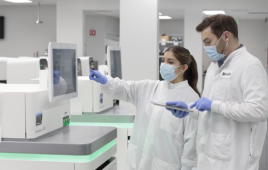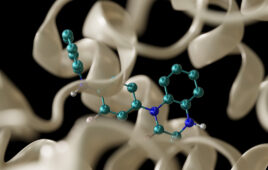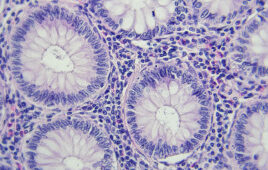Chromatin immunoprecipitation coupled with tiling microarrays interrogate promoters, chromatin structure, and much more.
The nice thing about tile is that individual pieces can be placed very close together, abutting each other. And that is also the nice thing about tiling microarrays—oligonucleotide probes containing sequences that lie very close to each other in a genome. As the name implies, tiling arrays “tile” a genome. And over the last five years, tiling arrays have been put to good use.
Richard Jenner, MA, PhD, MRC Career Development Fellow, MRC/UCL Centre for Medical Molecular Virology Division of Infection and Immunity, University College, London, UK, is coupling chromatin immunoprecipitation (ChIP) with tiling microarrays (known as the ChIP-chip method). The objective of Jenner’s research is “to find the genomic location of specific DNA-binding proteins in living cells.” In other words, he wants to identify genes that are regulated by these transcription factors.
Jenner uses a tiling microarray platform from Agilent Technologies, Santa Clara, Calif., which contains probes that are spaced about every 200-bp along the length of the human genome, tiling regions around promoters. For the specific promoter tiling array, he “tiles 4-kb upstream and 4-kb downstream of almost all known human genes.”
 click to enlarge Outline of the protocol for the ChIP-chip method. (Source: David Steger, PhD) |
Because promoter regions may contain conserved DNA sequences, Jenner minimizes cross-hybridization on the array by selecting only unique sequences for the probes. “It is not possible to go across the entire genome with a single array because only a limited number of features can be fitted on the glass slide,” says Jenner. “The majority of known DNA-binding sites are in [the areas we interrogate], but we are missing some by not going beyond that area.” But using the tiling array provides Jenner with the general positions for these regulatory proteins giving him “a good idea about the chromosomal distribution of a particular DNA-binding protein.”
To identify the specific target genes of their DNA-binding protein of interest, Jenner employs the ChIP-chip method. The sample usually consists of human cells grown in culture, human blood, or human tissue; all containing living cells. To freeze the DNA-protein interactions, the cells are cross-linked with formaldehyde. Cells are then lysed to release genomic DNA, which is subsequently fragmented using a sonicator. An antibody attached to magnetic beads and reactive against the DNA-binding protein of interest is then incubated with the genomic DNA mixture. Following incubation, a magnet is used to pull out the complex containing the antibody attached to the DNA-binding protein of interest bound to genomic DNA fragments. The beads are then washed to remove non-specific interactions and the DNA is then purified away from the beads and amplified. The amplified DNA (which is the fraction of immunoprecipitated DNA) is labeled with a red fluorescent dye called Cy5 and total genomic DNA (which is the genomic DNA from the initial lysate and referred to as input) is labeled with a green fluorescent dye called Cy3.
Now comes the “chip” part of ChIP-chip method. Cy3- and Cy5-labeled DNA is then mixed and hybridized to the tiling array. “The DNA regions that were bound to a protein find their specific probe on the array and they show up as more of a red color, whereas the bits of the genome that were not bound by our specific protein show up as yellow,” says Jenner. “And the software we use quantifies the ratio of red to green and gives us a number, which is the fold-enrichment of that DNA sequence in our immunopurifed sample compared to the whole DNA. And so what you can do then is plot that specific enrichment for that specific oligo probe and you can also plot that fold-enrichment that you get for its neighboring probes.” The result of plotting is a peak of redness—which corresponds to the probes that represent where that DNA-binding site is present in the genome. “So, we then link those binding sites with the genes we think those binding sites regulate. Usually we look at genes within one kilobase of that binding site. So the identity of those genes will give us some idea of what that DNA-binding protein is doing.”
Jenner cites three main reasons for using tiling arrays. “The first reason is that they cover a larger expanse of the genome than traditional microrarrays. The second reason is by having multiple probes, appropriately spaced, the number of probes voting for a candidate binding site increases, and therefore our confidence that the binding site is real increases. The third reason is that having multiple probes means that the exact location of a binding site can be identified with greater accuracy.”
More than DNA-binding
Tiling arrays are also used to study chromatin structure. One researcher using tiling arrays for this purpose is David J. Steger, PhD, senior research investigator, Institute of Diabetes, Obesity and Metabolism, Division of Endocrinology, Diabetes and Metabolism, University of Pennsylvania School of Medicine, Philadelphia, Pa. Steger studies modification of histone proteins and the biological effects of those modifications. Specifically, he is interested in identifying the location of these modifications. “Tiling arrays offer a way to do that in a high-throughput and genome-wide manner, which, before tiling arrays came about, was not possible,” says Steger.
Steger is interested in a methylase enzyme that methylates histone proteins. He uses the ChIP-chip method to locate where the methylation occurs in the genome. For the ChIP, he uses an antibody that is specific for the position of different posttranslational modifications on histones, such as lysine-79 methylation or lysine-4 methylation. “There are many degrees of methylation; it could be mono-, di-, or trimethylated. We have commercially-available antibodies that recognize all those different forms,” says Steger. He is interested in the identity of the DNA fragment cross-linked to the specific protein pulled out with this antibody; and the identity of this fragment is determined by tiling microarray.
Similar to Jenner’s ChIP-chip method described above, Steger is also looking for enrichment of signal from the immunoprecipitated sample over the input sample on the tiling array. It is the ratio of Cy3 (green) signal over Cy5 (red) signal that determines enrichment. “If it is enriched, you usually see more red than green. And you might see a ratio of 200-fold. That means that the methylation mark is present in that region of the genome,” Steger says.
Steger uses custom-made tiling arrays from Agilent; he designed the arrays and Agilent printed them. Each array has 105,000 features. “The tiling aspect refers to the fact that you have repeating sequences located close to one another. So you just basically, as the word implies, tile along a chromosome,” says Steger.
Tiling array experts agree that the density of the array determines its resolution. “The more info you have on an actual slide, the higher your resolution can be. If [the tiling array] encompasses the entire genome, you have all of the sequence that is present but not repetitive. And unfortunately that does mean leaving out about half the genome,” says Steger.
RNA metabolism
Brian D. Gregory, PhD, a Damon Runyon postdoctoral fellow in Dr. Joseph R. Ecker’s laboratory at the Salk Institute for Biological Studies, La Jolla, Calif., uses tiling arrays to study other things. Gregory is interested in the biology of ribonucleases that regulate mRNA stability in the plant Arabidopsis thaliana, an interest that has led him to use tiling arrays to map substrates of ribonucleases. He also uses tiling arrays to look at changes in gene expression resulting from mutations in specific proteins involved in RNA metabolism.
For Gregory, a typical experiment to study Arabidopsis gene expression begins with preparation of total RNA from the plant. The RNA is then mixed with an oligo dT primer to make a DNA copy of the RNA. The T7 promoter attached to the oligo dT primer is then used to make thousands of copies of complementary RNA (cRNA) molecules using the DNA as a template. cRNA molecules are then “hydrolyzed into smaller pieces to make targets for hybridization to the arrays.” Finally, these molecules are hybridized overnight to the arrays. The next day, the arrays are washed, stained, and scanned. The array data is then analyzed.
Gregory and colleagues choose tiling arrays over classical gene expression arrays because the gene expression arrays do not include intergenic transcripts of the genome, only mRNA transcripts. “You choose a tiling array because you want to get an overview of what’s going on across the entire genome,” says Gregory.
The development of the first whole-genome Arabidopsis tiling array occurred in 2004-2005—a collaboration between Gregory’s mentor, Joseph R. Ecker, and Affymetrix, Inc., Santa Clara, Calif. This tiling array is now available through Affymetrix. Currently, Affymetrix produces the Arabidopsis Tiling 1.0R array—a reverse chip that interrogates the Watson strand (5’ to 3’) of the Arabidopsis genome—and the Arabidopsis Tiling 1.0F array to interrogate the complementary Crick strand (3’ to 5’). “So, using both arrays, you get strand-specific info, which is important, especially when it comes to gene expression,” says Gregory.
Editor’s note: In addition to Affymetrix and Agilent Technologies, Roche NimbleGen, Inc., Madison, Wis., is also a major manufacturer of tiling microarrays.
This article was published in Drug Discovery & Development magazine: Vol. 11, No. 6, June, 2008, pp. 37-39.
Filed Under: Genomics/Proteomics




